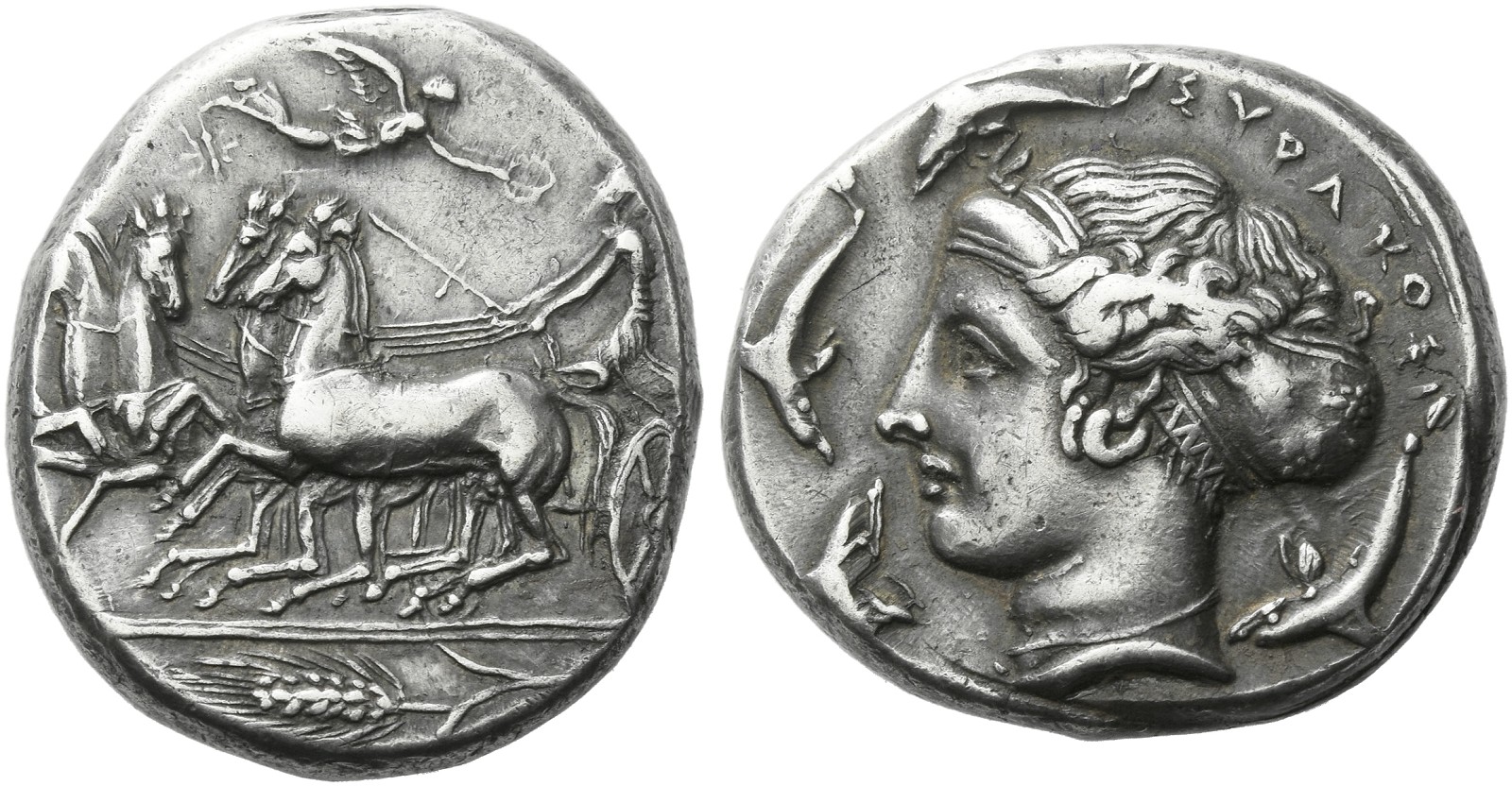Syracuse, silver, tetradrachms (quadriga/Arethusa) (413-399 BCE) (Fischer-Bossert)
From SILVER
413 BCE - 399 BCE Silver 5,893 kg
Description
| ObverseInscription or printing placed on the obverse.: | ΣYPAKOΣION or ΣYPAKΩΣION (Greek).Fast quadriga driven l. by charioteer holding kentron and reins, above, Nike flying r. to crown him. Star above horses. Barley grain in exergue |
| ReverseInscription or printing placed on the reverse.: | ΣYPAKOΣION, ΣYPAKOΣIOΣ or ΣYPAKOΣIΩΝ (Greek).Head of Arethusa l., hair caught up in ampyx and sphendone, wearing double earring and single-pendant necklace, around, four dolphins and, in exergue, ear of barley with stalk and leaves |
Mint and issuing power
| MintIdentifies the place of manufacture or issue of a numismatic object.: | Syracuse | Ancient regionAncient region.: | Sicily | Modern countryModern country: Italy | AuthorityIdentifies the issuing power. The authority can be "pretended" when the name or the portrait of X is on the coin but he/she was not the issuing power. It can also be "uncertain" when there is no mention of X on the coin but he/she was the issuing power according to the historical sources: |
Chronology
| FromIdentifies the initial date in a range assigned in a numismatic context. | 413 BCE | toIdentifies the final date in a range assigned in a numismatic context.. | 399 BCE | PeriodTime period of the numismatic object.: Classical 480-323 BC |
Physical description
| MetalThe physical material (usually metal) from which an object is made.: | Silver |
Median weightMedian of the weights of numismatic objects (in grams). in grams | 17.10 | DenominationTerm indicating the value of a numismatic object. Examples: tetradrachm, chalkous, denarius.: | tetradrachm |
StandardStandard.: | Attic |
Image

S 1078 - Syracuse, silver, tetradrachm, 413-399 BC.jpg [1]
References
| Die study referencePublication of the study: | Fischer-Bossert 20171Fischer-Bossert 2017, p. 146-178 (O15-O32) | ||
| Coin series referenceReference to coin series study: | Tudeer 19132Tudeer 1913 | ||
| Coin series web referenceCoin series web references: | |||
Obverse dies distribution
| FrequencyFrequency of specimen in distribution. ᵖ | Number of obversesNumber of obverse dies. ᵖ (o) | % (o) | Number of coinsNumber of coins. (n) | % (n) | Die nameName(s) of the die(s). |
| 1 | 1 | 5.56 | 1 | 0.16 | 17 |
| 3 | 1 | 5.56 | 3 | 0.48 | 24 |
| 9 | 2 | 11.11 | 18 | 2.87 | 19, 23 |
| 15 | 1 | 5.56 | 15 | 2.39 | 16 |
| 17 | 1 | 5.56 | 17 | 2.71 | 20 |
| 25 | 2 | 11.11 | 50 | 7.96 | 28, 29 |
| 26 | 1 | 5.56 | 26 | 4.14 | 31 |
| 30 | 1 | 5.56 | 30 | 4.78 | 18 |
| 42 | 1 | 5.56 | 42 | 6.69 | 25 |
| 43 | 1 | 5.56 | 43 | 6.85 | 22 |
| 45 | 1 | 5.56 | 45 | 7.17 | 26 |
| 49 | 1 | 5.56 | 49 | 7.8 | 27 |
| 58 | 1 | 5.56 | 58 | 9.24 | 30 |
| 59 | 1 | 5.56 | 59 | 9.39 | 32 |
| 84 | 1 | 5.56 | 84 | 13.38 | 15 |
| 88 | 1 | 5.56 | 88 | 14.01 | 21 |
| Total | 18 of 18 | 100.06 | 628 of 628 | 100.02 |
Reverse dies distribution
no distribution is available
Quantification
| Number of obversesNumber of obverse dies. ᵖ (o) | 18 | Number of singletons (o1)The number of singleton coins. ᵖ | 1 |
| Number of reverse diesNumber of reverse dies. (r) | 32 | Number of coinsNumber of coins. (n) | 628 |
| Coins per obverse dieNumber of coins per obverse die. (n/o) | 34.89 | Coins per reverse dieNumber of coins per reverse die. (n/r) | 19.63 |
| Reverse per obverse ratioRatio of obverse dies divided by reverse dies. (r/o) | 1.78 | Percentage of singletons (o1)number of coins (n) divided by the number of singletons (o1) ᵖ | 5.56 % |
| Original number of dies (O) (Carter 1983 formula)The estimation of the number of coins according to Carter 1983 ᵖ | 17.23 | Coins struck if 20,000 as average productivity per dieCoins made if the average productivity for obverses (according to Carter) is 20,000. ᵖ | 344,600 |
| Original number of dies (O) (Esty 2011 formula)The estimation of the number of coins according to the singleton formula in Esty 2011 ᵖ (O) | 18.53 | Survival rate if 20,000 as average productivity per dieSurvival rate if average productivity is 20,000. ᵖ | 0.00182 |
| Coverage (o = % of O) (Esty 1984 formula)Esty 1984 - coverage (% of O) ᵖ (o = % of O) | 99.84% | Die productivity if survival rate 1/2,000Average productivity if survival rate is 1/2,000. ᵖ | 72,896.11 |
| Weight of silver (in kg) if 20,000 coins per die (O = Carter formula)Carter 1983 * Median weight * 20000 (*10 if gold or electrum) ᵖ | 5,893 kg <br /> 5,893 kg | Die productivity if survival rate 1/5,000Average productivity if survival rate is 1/5,000. ᵖ | 182,240.28 |
Remarks
Most likely one single workstation Likely military
References
- ^ Fischer-Bossert, Wolfgang (2017), Coins, Artists, and Tyrants. Syracuse in the Time of the Peloponnesian War, Numismatic Studies 33, New York, The American Numismatic Society, 371 p., 27 pl., 30 cm.
- ^ Tudeer, Lauri O. Th. (1913), Die Tetradrachmenprägung von Syrakus in der Periode der Signierenden Künstler, Berlin, 292 p. : ill., VII pl. ; 24 cm.